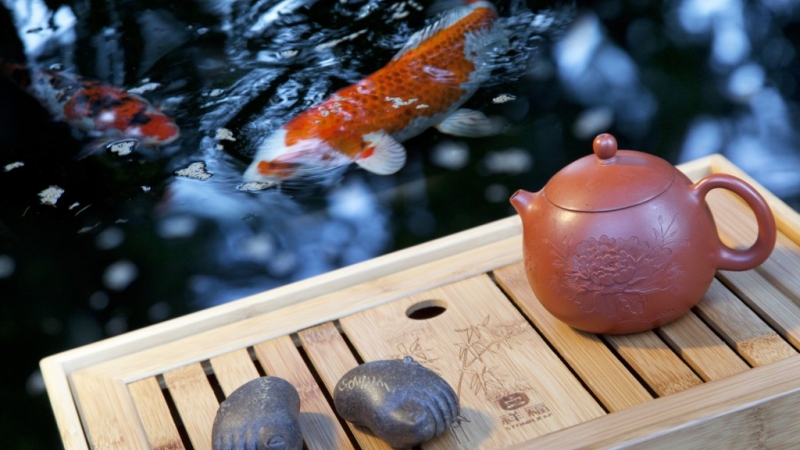The term “Gong Fu” in Chinese means skillful, and “Gong Fu” Tea Preparation refers to a method of preparing tea with a Chinese Miniature Yixing teapot that enhances the enjoyment of the tea experience.
Initial preparation
Collect clean teapot, tea boat, tea pitcher, teacups, and loose tea. Boil water in a small kettle to the appropriate temperature. Optional equipage: saucers, smelling cups, tea tray, tea funnel, tea utensils, and waste water container.
Heat Equipment
Place teapot in the tea boat. Using the kettle, carefully fill the teapot with hot water. Replace the lid on the top of the teapot and pour hot water over the teapot. Fill all the cups (and smelling cups) with hot water. After everything is heated, dispose of the water in the teapot and cups.
First steep
Scoop loose tea leaves into the warm teapot. As a general guideline, if the tea leaves are tightly rolled (e.g. Oolong), the leaves should fill a quarter of the teapot. If the tea leaves are not tightly rolled (e.g. Pouchong), the leaves should fill up to one-half of the teapot.
Experiment to discover the right amount of leaves for your teapot. Pour hot water over the leaves until the teapot is filled. Steep for around one minute. Dry the bottom of the wet teapot with a towel and transfer the brewed tea from the teapot to the tea pitcher.
Optional step with smelling cup
Line up the smelling cups. With the tea from the tea pitcher, fill each smelling cup to approximately 50% capacity. After a couple of seconds, empty the tea from each smelling cup into its matching teacup “partner.” Offer the empty smelling cup to each guest for his or her enjoyment of the aroma of the tea.
First service
Line up the teacups (with saucers). With the tea from the tea pitcher, fill each teacup to approximately 70% capacity and offer the cup (with saucer) to each guest. Take some time to enjoy the color, fragrance, taste, and aftertaste of the tea, tea set, and the ongoing conversation with friends and family.
Second steeping
Before the first guest completely consumes his or her cup of tea, reheat the water in the kettle if needed. Pour hot water into the teapot with the same previously steeped leaves. Steep for around one minute and transfer the tea from the teapot into the tea pitcher.
Second service
Serve the tea from the tea pitcher by refilling each guest’s cup to about 70% capacity.
Successive steepings
Reheat water if needed. Pour hot water into the teapot with steeped leaves. Lengthen the steeping time an additional 15-20 seconds for each successive steep (e.g. The third step would be about 1 minute and 15 seconds. The fourth step would be about 1 minute and 30 seconds.).
The slightly additional steeping time should help to keep consistency in the tea taste without overstepping. High-quality tea leaves should be able to be steeped 4 to 6 times. Transfer the steeped tea into the tea pitcher and serve as before.
In the beginning, you may experience some tea or water spillage or be unable to prepare the tea in time before some of the teacups run dry, but with practice and use of “Gong Fu” tea preparation, you will soon experience the enhanced enjoyment of the tea time, tea, and teaset.
Why Does Purple Clay Change the Taste?
Purple clay contains 6-7% of iron. Iron in natural clay is usually in oxidized form and it is not active.
It is activated when baked in an unsaturated fire at high temperatures. If there is a sufficient intake of oxygen, the fire will be blue in color and will in turn supply oxygen to the clay.
On the other hand, if there is a lack of oxygen, the fire will be red in color and generate Carbon Monoxide as well as smoke. This red fire is called unsaturated fire that reduces the oxygen from the clay. Once the clay is reduced, the oxygen is taken away from the mineral and eventually mineral gets active.
This is called activation of clay. Activated clay can interact with water molecules and change its cluster. In fact, purple clay is not reacting with the tea itself, but with the water. In reality, any clay could be activated as long as it is baked in unsaturated fire. However different clay gives the different extent of reaction.
However above explanation is not sufficient to understand why certain clay has great performance and other is not.
Some people comment how important the mineral content is. Honestly speaking, it is very easy to analyze the specific mineral content and artificially blend it in order to “create” clay that mineral content is identical with good clay. In a way, it is also easy to copy Yi Xing clay in terms of mineral composition.
However, no matter how identical the mineral composition is, it does not perform as good as original clay.
It is due to the surface area. The natural clay has a higher melting point and therefore mineral exists in granule shape, while artificially added mineral get melted at mich lower temperature. Once mineral gets melted like glazing, it drastically reduces surface area and effect of clay disappear drastically.



